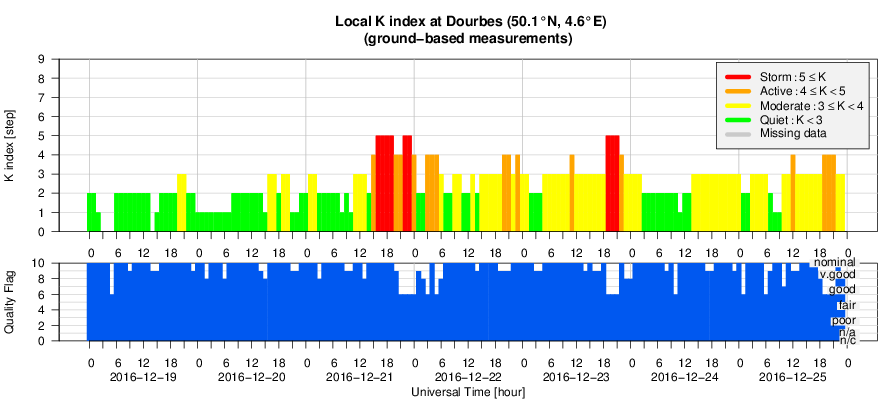- Table of Content
- 1.Review of sola...
- 2.The Internatio...
- 3.Review of geom...
- 4.Geomagnetic Ob...
- 5.Review of iono...
- 6.Future Events
2. The International Sunspot Number
3. Review of geomagnetic activity
4. Geomagnetic Observations at Dourbes (19 Dec 2016 - 25 Dec 2016)
5. Review of ionospheric activity (19 Dec 2016 - 25 Dec 2016)
6. Future Events
Review of solar activity
Solar activity was extremely low with no C-class flares reported. There has been only one B2.7 flare peaking at 14:19 UT on 21-Dec-2016, coming from Active Region (AR) 2620.
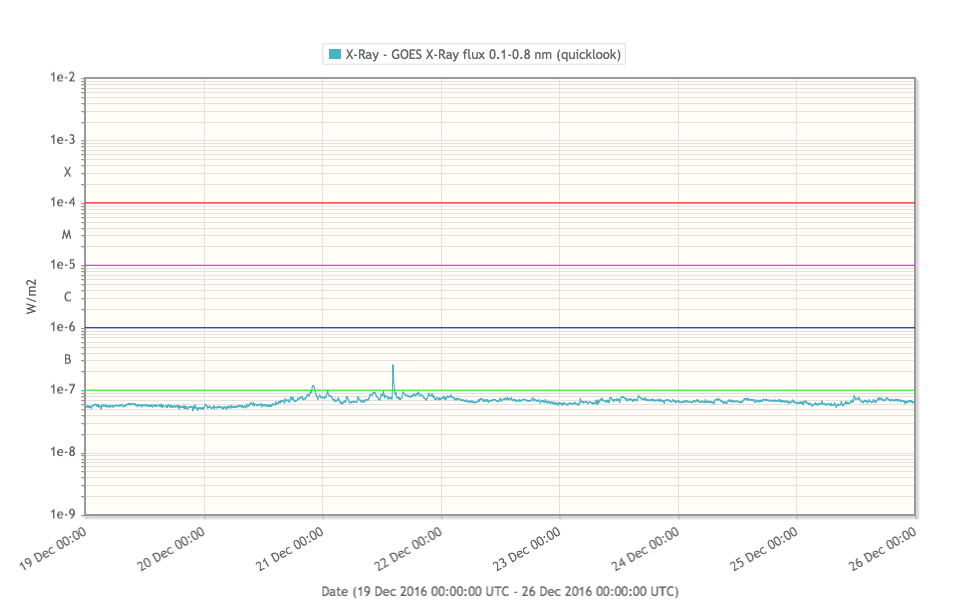
AR 2620 is probably the first AR of the next solar cycle 25 due to its high latitudinal position and reverse polarity in comparison with the AR of the current cycle.
Further, there were no ARs of any significance on the Sun. NOAA AR 2619 and 2620 rotated over the west solar limb.
No Earth directed CME was detected over the past week. Solar protons have remained at background levels. The large equatorial coronal hole with the low latitude extend has been geo-effective from 21-Dec-2016 till 26-Dec-2016. The lack of significant ARs and coronal holes suggests solar activity will remain low for the next few days.
The International Sunspot Number
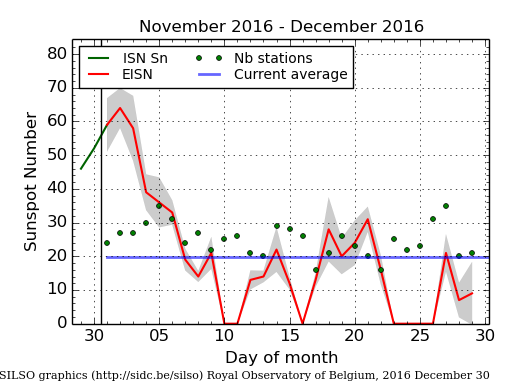
The daily Estimated International Sunspot Number (EISN, red curve with shaded error) derived by a simplified method from real-time data from the worldwide SILSO network. It extends the official Sunspot Number from the full processing of the preceding month (green line). The plot shows the last 30 days (about one solar rotation). The horizontal blue line shows the current monthly average, while the green dots give the number of stations included in the calculation of the EISN for each day.
Review of geomagnetic activity
The solar wind speed was below 360 km/s and the geo-magnetic indices - both planetary Kp and local K Dourbes - were ranged between 0 and 2 for the first days of this week.
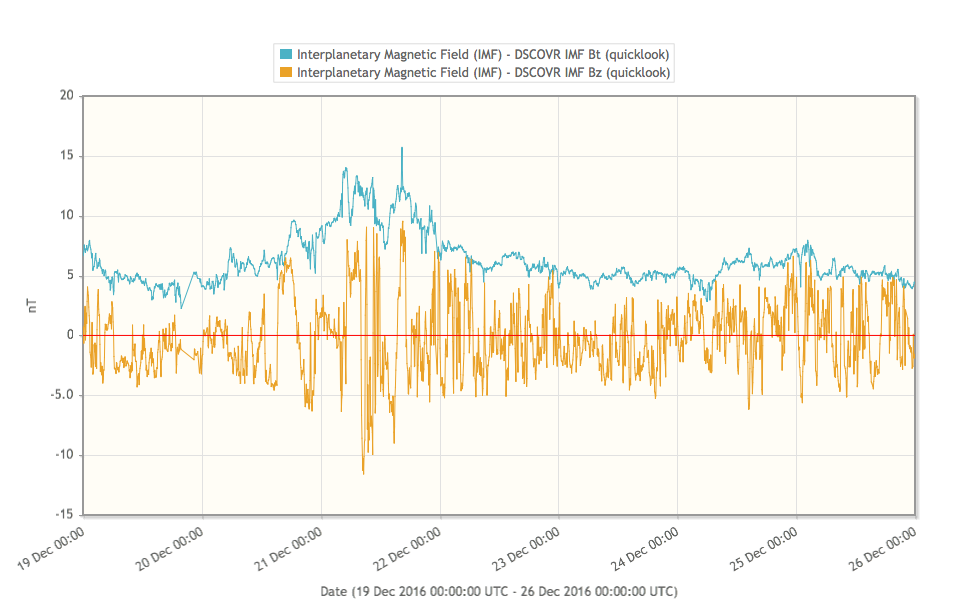
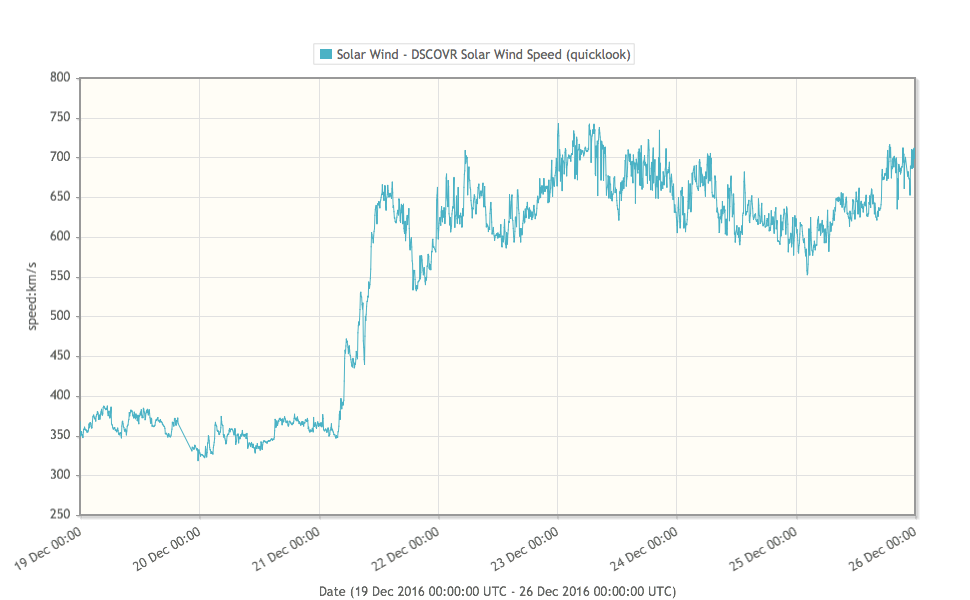
On 21-12-2016, the anticipated arrival of the high speed stream (HSS) from a large coronal hole (CH) increased the solar wind speed, which was varying between 630 and 730 km/s till the end of the week (DSCOVR data). On 20-Dec-2016, Bz varied between -5 and +5 nT, on 21-Dec-2016, the range of the Bz fluctuations increased from -10 and +10 nT.
Active to moderate geomagnetic conditions were recorded. K Dourbes index was ranged between 3 and 5 and NOAA Kp index between 3 and 5, most of the time for the rest of the week, with a singular episode of Kp= 6 on 21-Dec-2016 at 15:00 UT.
Review of ionospheric activity (19 Dec 2016 - 25 Dec 2016)
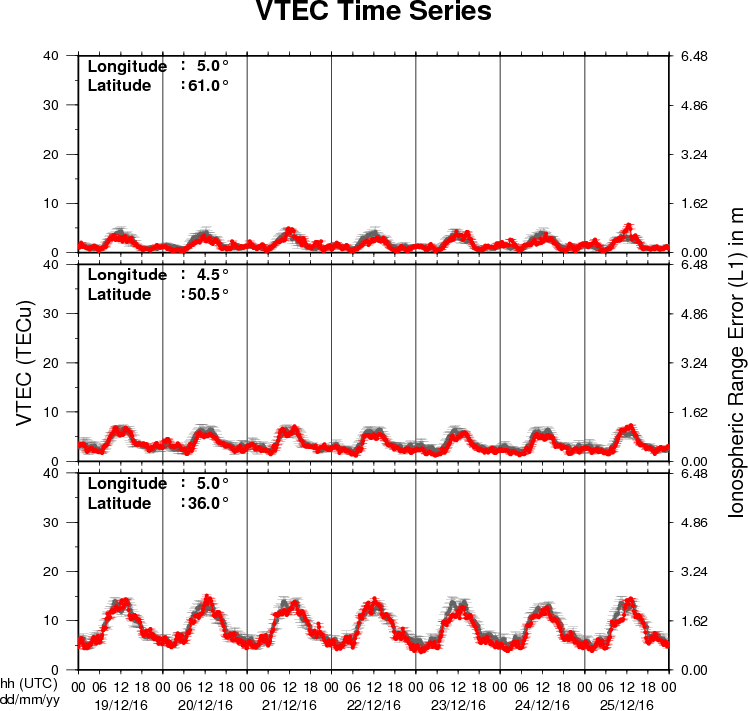
The figure shows the time evolution of the Vertical Total Electron Content (VTEC) (in red) during the last week at three locations:
a) in the northern part of Europe(N61°, 5°E)
b) above Brussels(N50.5°, 4.5°E)
c) in the southern part of Europe(N36°, 5°E)
This figure also shows (in grey) the normal ionospheric behaviour expected based on the median VTEC from the 15 previous days.
The VTEC is expressed in TECu (with TECu=10^16 electrons per square meter) and is directly related to the signal propagation delay due to the ionosphere (in figure: delay on GPS L1 frequency).
The Sun's radiation ionizes the Earth's upper atmosphere, the ionosphere, located from about 60km to 1000km above the Earth's surface.The ionization process in the ionosphere produces ions and free electrons. These electrons perturb the propagation of the GNSS (Global Navigation Satellite System) signals by inducing a so-called ionospheric delay.
See http://stce.be/newsletter/GNSS_final.pdf for some more explanations ; for detailed information, see http://gnss.be/ionosphere_tutorial.php
Future Events
For more details, see http://www.spaceweather.eu/en/event/future
4th SOLARNET Meeting: The Physics of the Sun from the Interior to the Outer Atmosphere, in Lanzarote (Spain)
Start : 2017-01-16 - End : 2017-01-20
The IV SOLARNET MEETING 'The physics of the Sun from the
interior to the outer atmosphere' will take place in Lanzarote
(Spain) from 16th to 20th of January 2017, organized by the
Instituto de AstrofÃsica de Canarias (IAC).
SOLARNET (High-resolution Solar Physics Network) is an EU-FP7
project coordinated by IAC with the aim of bringing together and
integrating the major European research infrastructures in the
field of high-resolution solar physics. SOLARNET involves all
pertinent European research institutions, infrastructures, and data
repositories. Networking activities, access to first-class
infrastructures and joint research and development activities are
being covered under SOLARNET to improve, in quantity and quality,
the service provided by this European community.
The purpose of this conference is to provide a coherent picture
of the Sun as a single physical system playing all the underlying
physical processes measured and observed in the solar atmosphere to
date.
Website:
http://www.iac.es/congreso/solarnet-4meeting/
Solar Orbiter Workshop 7: Exploring the solar environs in Granada, Spain
Start : 2017-04-03 - End : 2017-04-06
This event will be hosted by the Instituto de Astrofisica de
Andalucia - CSIC. Please mind that on April 7th the 20th SWT
meeting will take place at the same venue.
Website: Unkown
